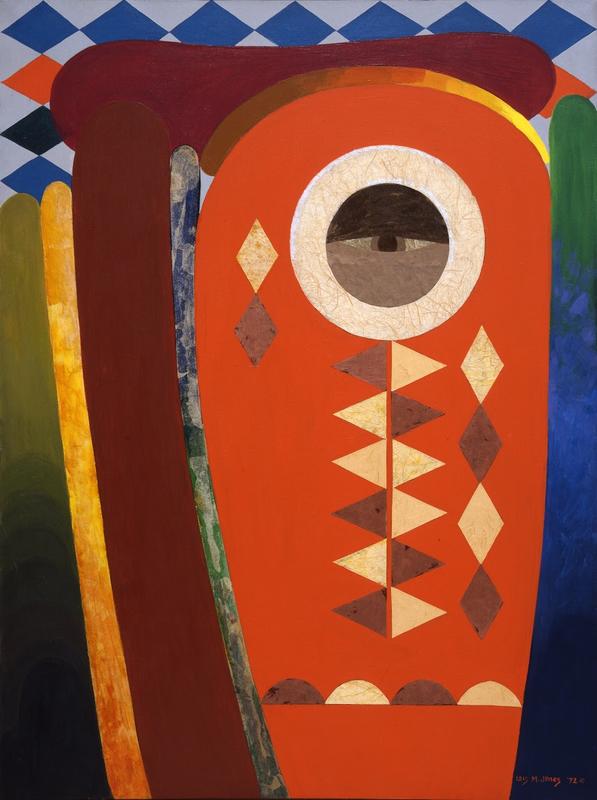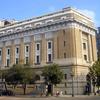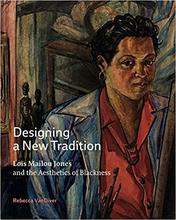More about Ode to Kinshasa
- All
- Info
- Shop

Contributor
You may be thinking to yourself right as you look at this painting that you’ve never seen a Picasso that invokes African themes.
Well, you still haven’t. Though there is some discussion about the influence of African masks in Picasso's Les Demoiselles d'Avignon, the famous artist's understanding of "Africa" was essentially a fantasy. He didn't really have any understanding of African culture, but was taken by the "otherness" of African imagery, reducing an entire continent to a very narrow European, and colonialist, perspective. Ode to Kinshasa turns Picasso on his head: a remix of European cubism and African images, filtered through an African American woman’s mind.
Lois Mailou Jones was an artist from Boston around the turn of the last century, and her well rounded artistic knowledge allowed her to pull from a bunch of styles in an effort to cultivate her own unique look and feel. The first of her major influences came from her many trips to France in the late 1930’s where she attended Académie Julian, founded by Rodolphe Julian. It was there that she began to broaden her creative understanding of other forms of artistic expression. But what she experienced more than anything, was a freedom from prejudice that she was not used to back in the states.
Years prior, when she was just getting started, older artists of color who had been in her position advised her to go to France for this exact reason. Her confidence then began to grow and she was able to create art about her culture because it interested her, not because she had a sense of obligation. That’s a big distinction. She eventually became one of the first African American artists to portray African imagery in their work with Les Fetiches.
Ode to Kinshasa is a painting that pays homage to the capital city of Zaire, now the Democratic Republic of the Congo. And while it was done at a much later date than her original dabble with African themes, it was created with a larger range of styles that really puts the whole message of the painting in a different light.
Jones depicts an African warrior in a traditional mask, lunging forward toward the viewer. But it’s painted in a cubist style, an undeniably European invention. There’s a lot to glean from a work of art like this, with ultimately no right answer as to what it’s specifically about. But when you put things into historical context, all the details begin to point in one direction.
The Republic of Zaire had previously been ruled by Belgium for almost a century. King Leopold II worked tirelessly to colonize and pillage the Congo of its rubber, exploiting and killing millions in the process. His exploits were so tyrannical that they served as inspiration for the imperial horrors described in Joseph Conrad’s Heart of Darkness. The region gained its independence in 1960 and it was finally given the opportunity to govern itself without monarchal interference. It was a big deal to say the least. Despite the country collapsing nearly 30 years later due to corruption and violence, it was undoubtedly, at least during the time that Jones completed this painting, an optimistic time in Kinshasa, and for anyone who valued sovereignty.
With all of that in mind, and with the clear mix of African and European inspiration, it can be interpreted that Jones had something to say about the Congo’s new state of being. The perspective of the painting is definitely conveyed in a way that it wants to put the viewer into the scene. That’s why it looks like the warrior is springing toward us. The cubist style might suggest that the warrior is actually attacking their European colonizers. Maybe this painting is Jones’ depiction of Zaire’s fight for freedom. And if that’s the case, she was able to weaponize European influences to create something that uplifts the people that the very same culture oppressed for so long.
Sources
- Britannica. “Lois Mailou Jones” Accessed December 23, 2019. https://www.britannica.com/biography/Lois-Mailou-Jones
- Crisp, James. “UN tells Belgium to apologise for colonial past in Congo” The Telegraph. February 12, 2019. https://www.telegraph.co.uk/news/2019/02/12/un-tells-belgium-apologise-…
- Lewis, Jo Ann. “The Transformation of Lois Mailou Jones” The Washington Post. February 1, 1990 https://www.washingtonpost.com/archive/lifestyle/1990/02/01/the-transfo…
- Munoz, Lorenza. “Education: Brush With Art Widens Children’s World” Los Angeles Times. March 26, 1995. https://www.latimes.com/archives/la-xpm-1995-03-26-we-47477-story.html












